Image Archive



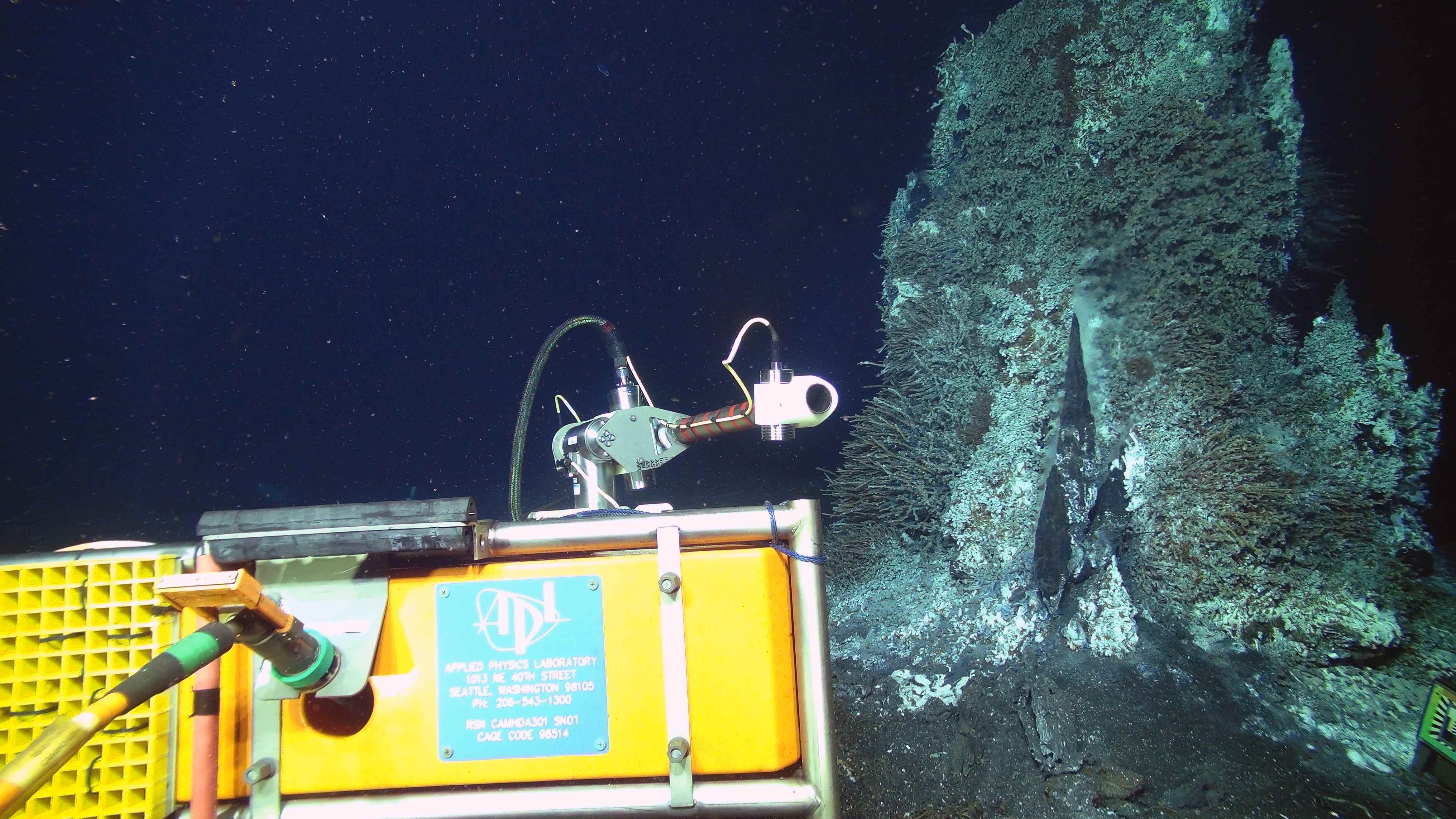
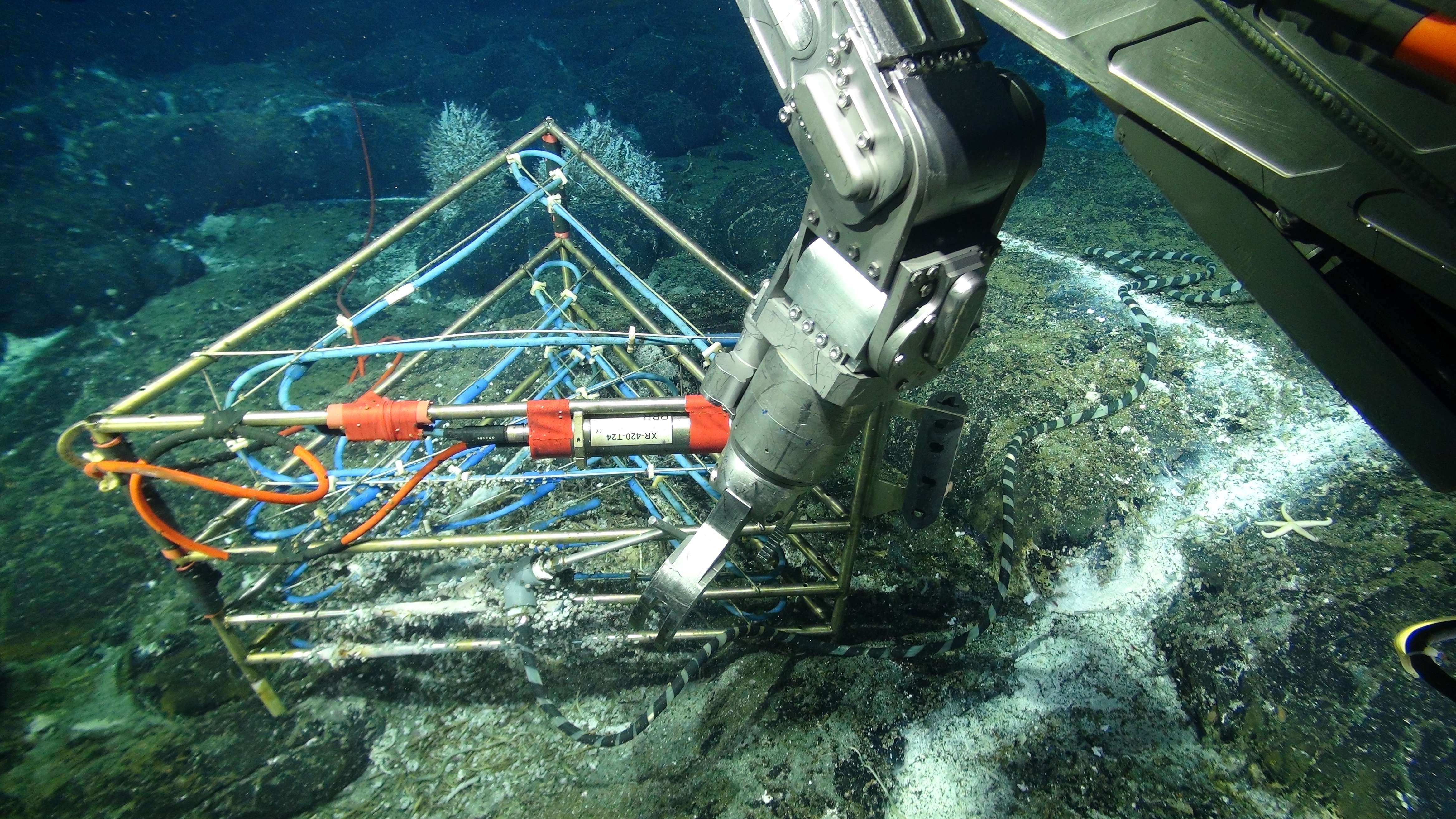






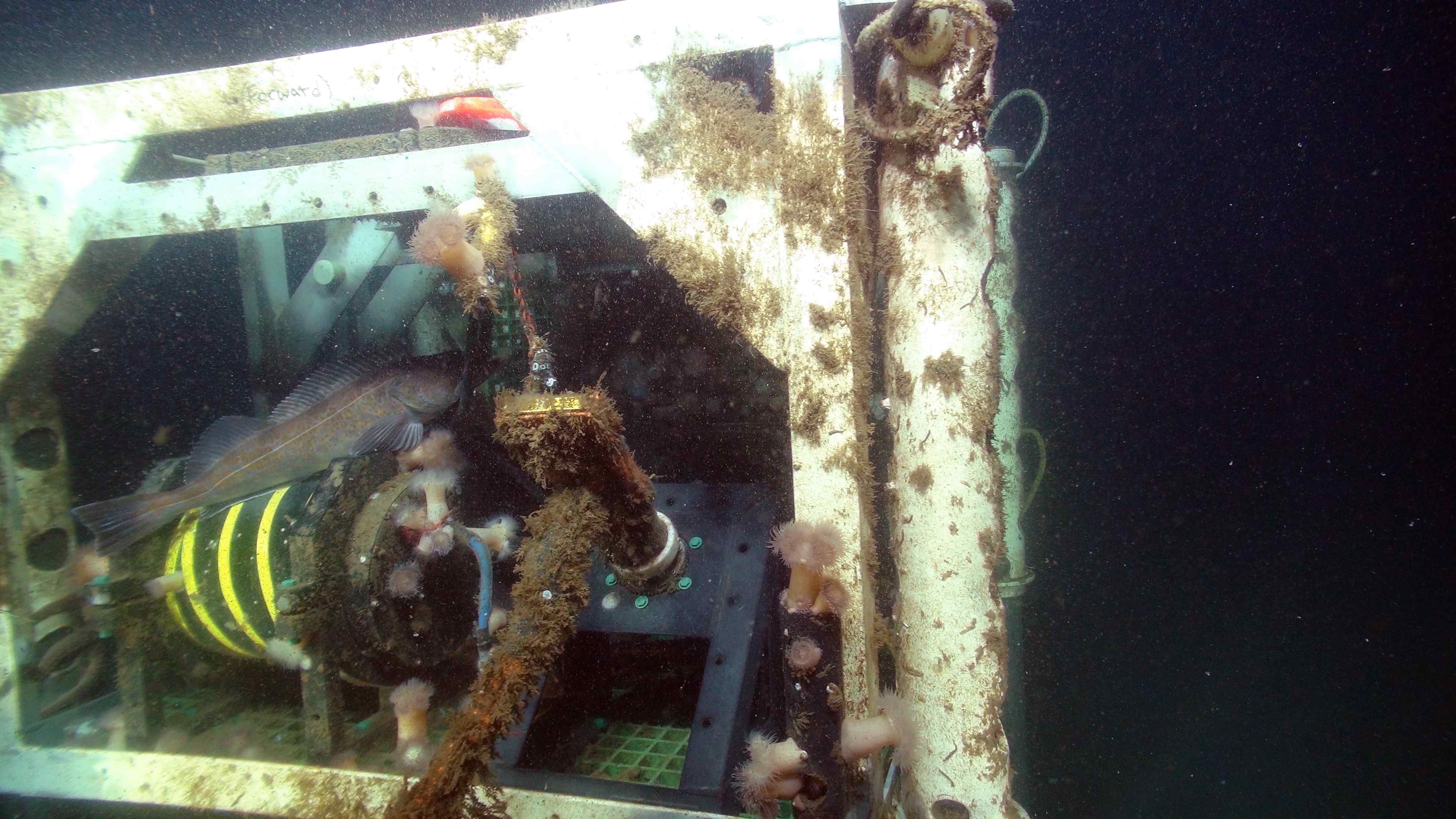
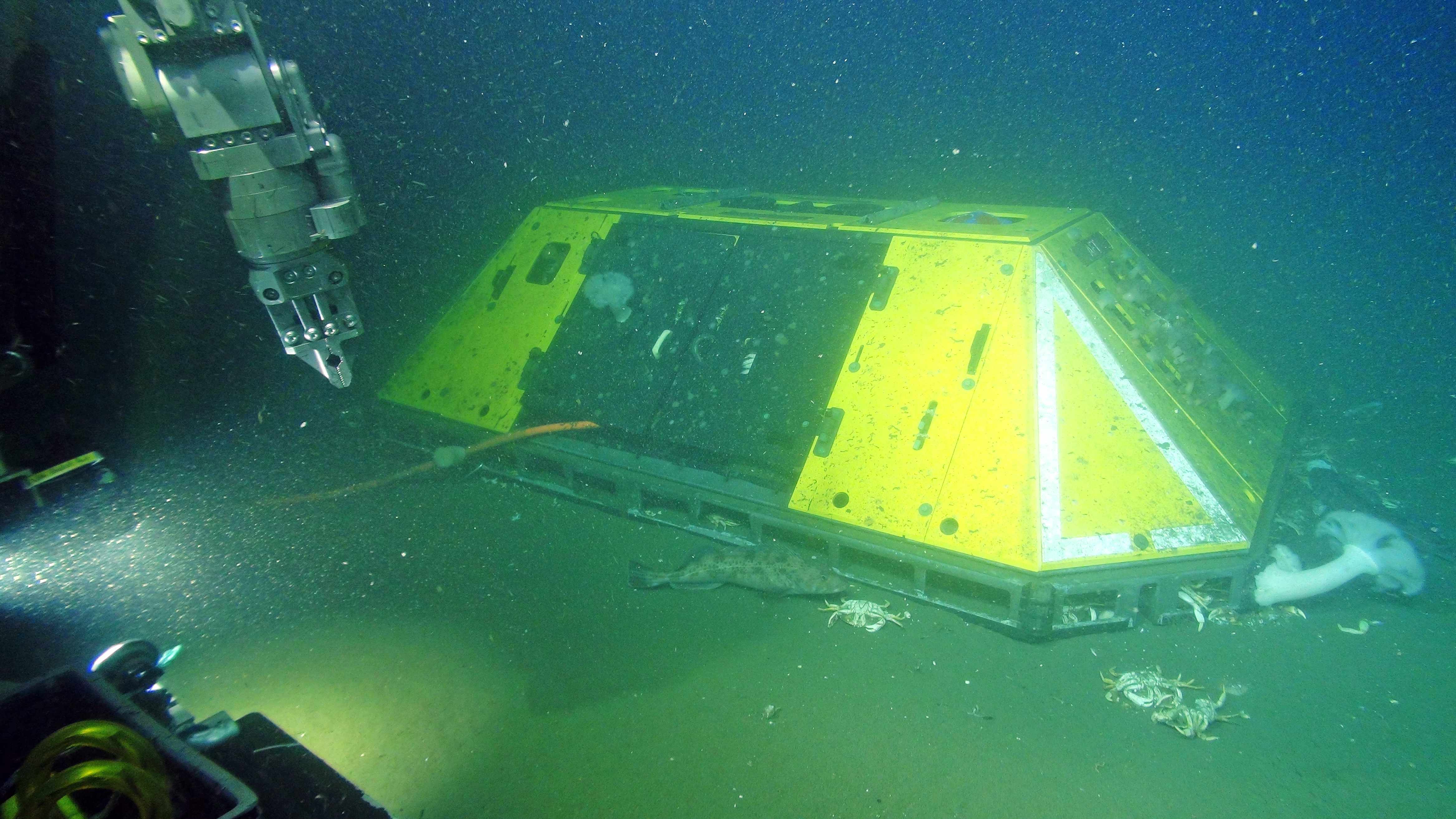

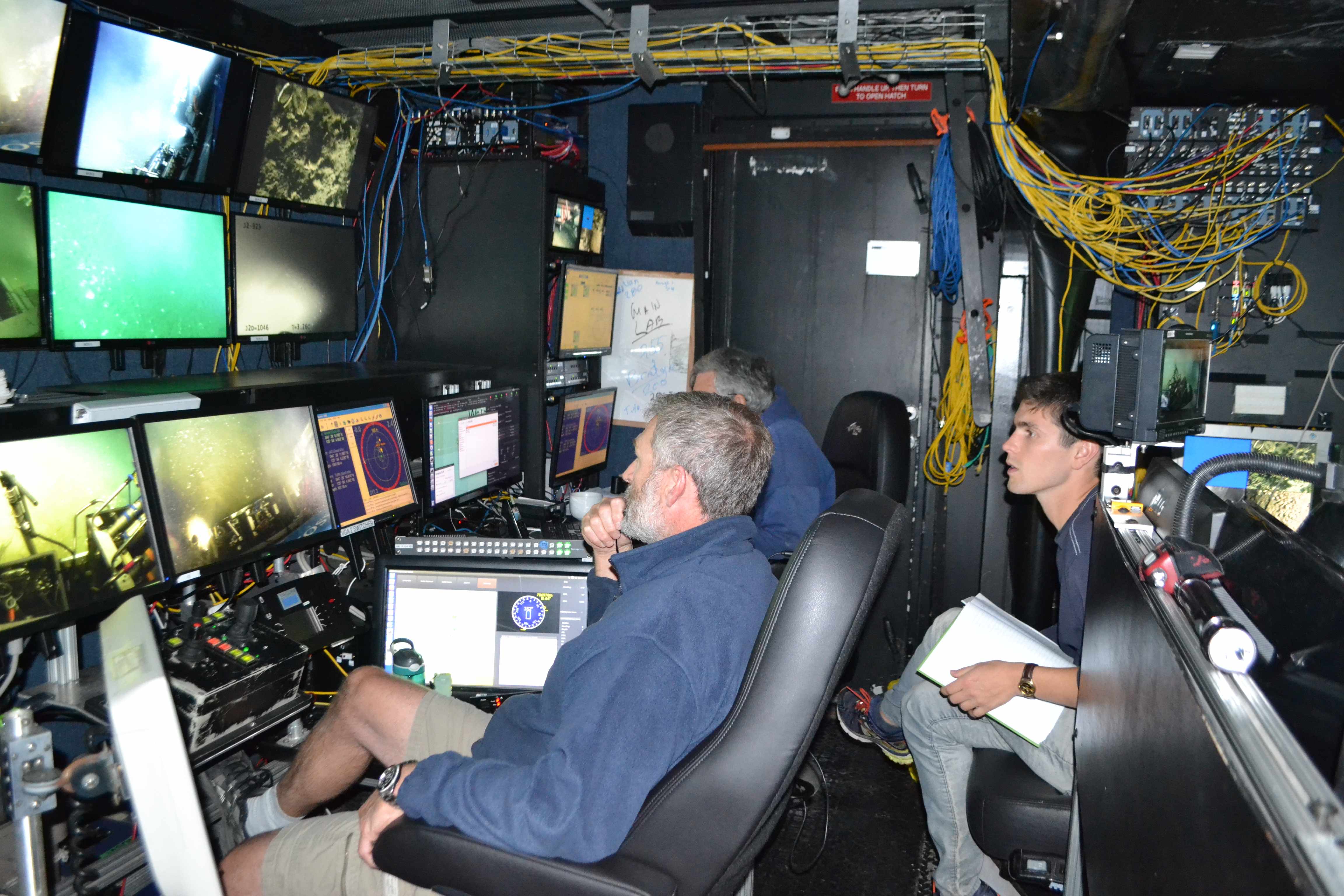






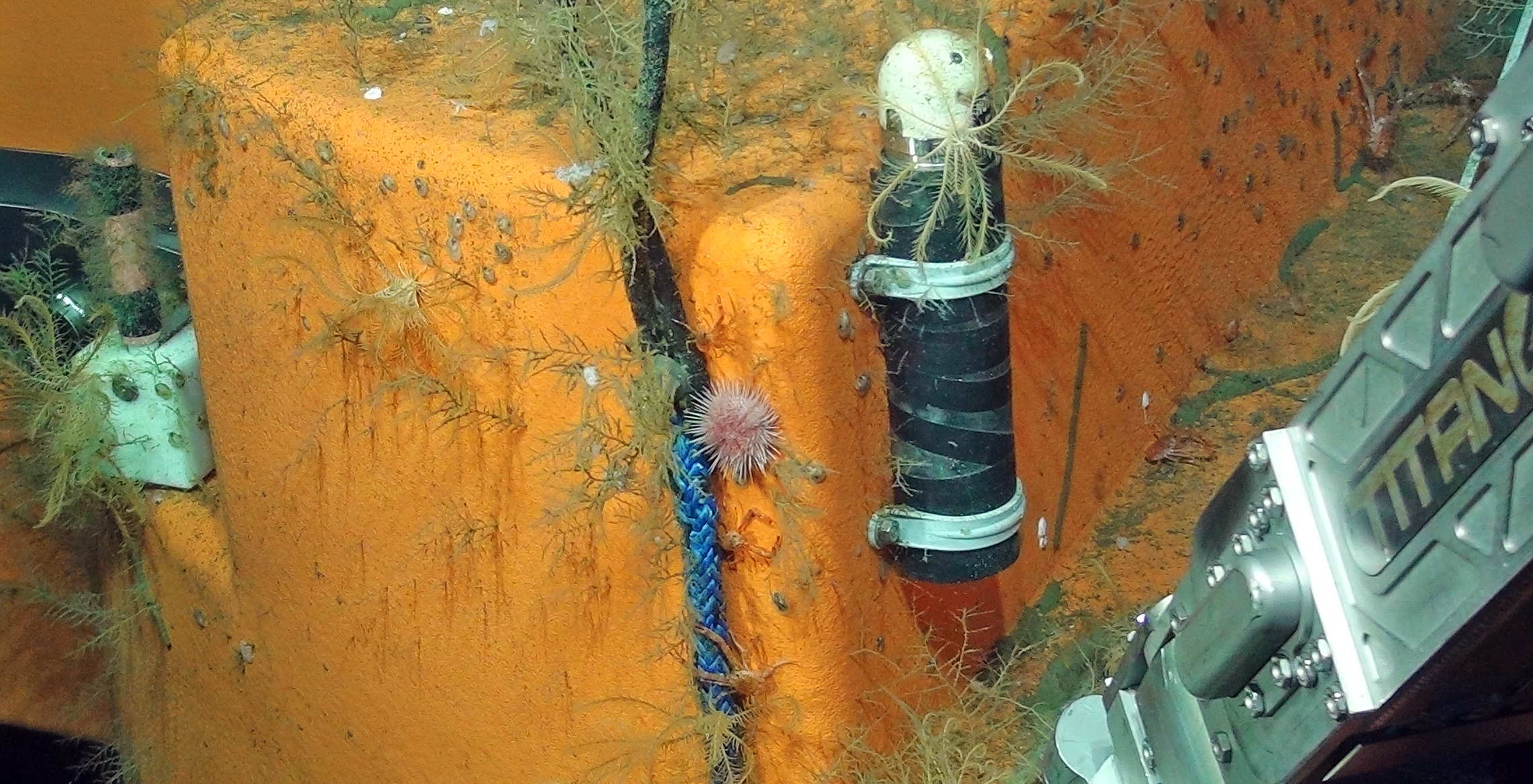
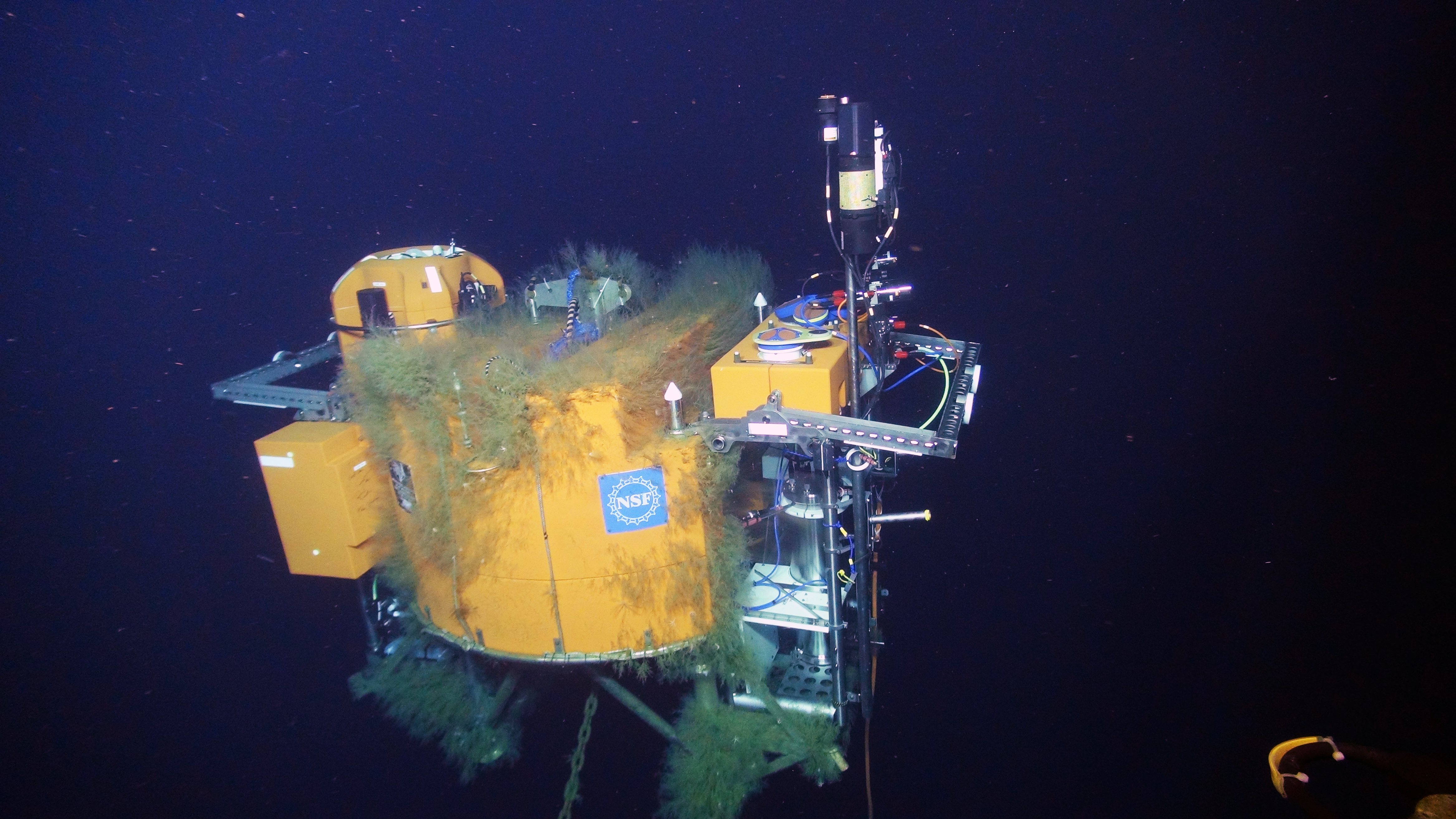

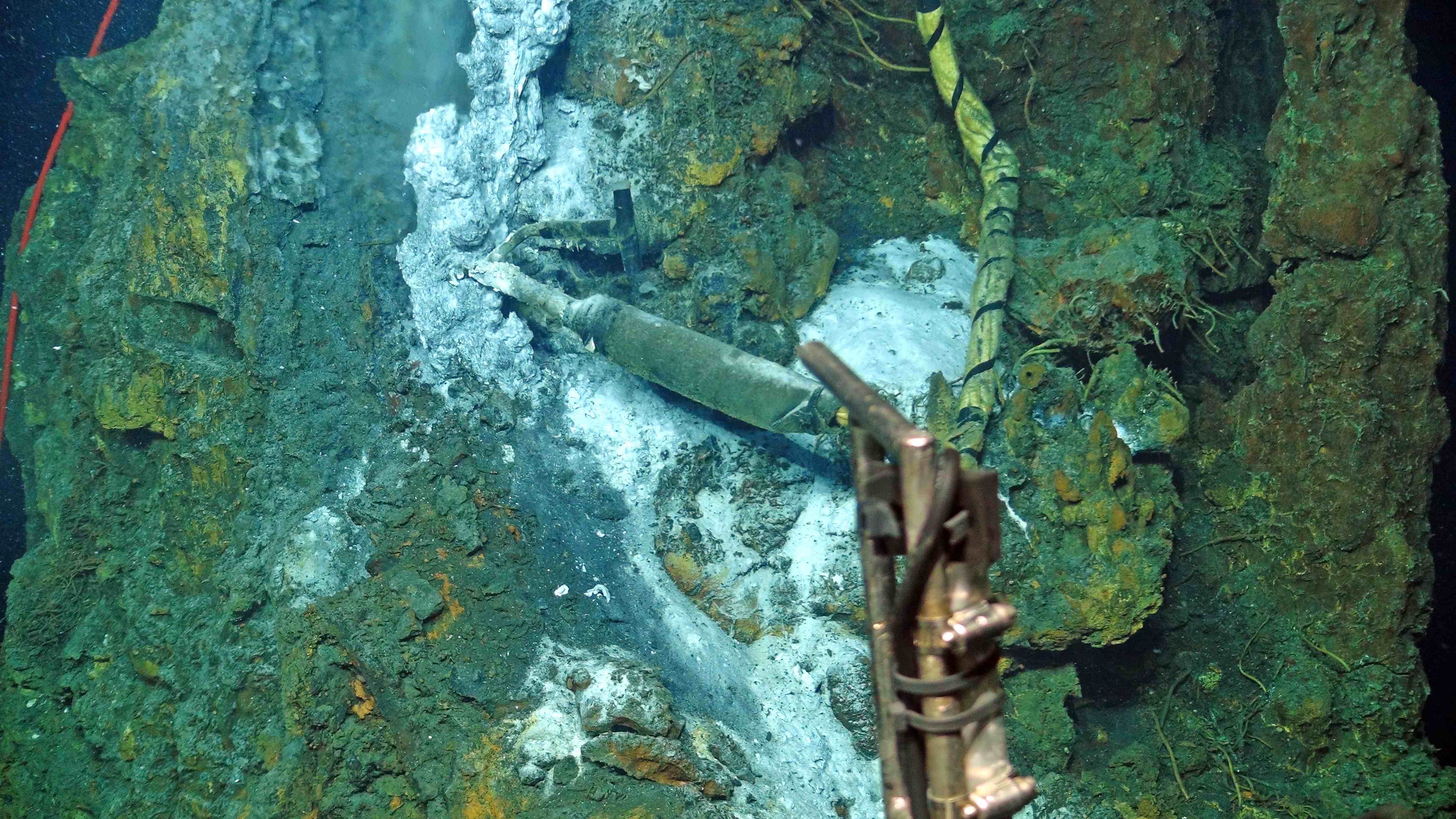




LED lights on the high definition camera, built by the Applied Physics Laboratory at the University of Washington, light up a ~1 m tall, young black smoker chimney at the base of the actively venting Mushroom edifice on Axial Seamount (water depth ~1500 m). The image, taken with the ROV Jason, shows the camera being tested by UW engineers during VISIONS16. They were in the Operations Center, located 300 miles to the east at the School of Oceanography. Here, they were commanding/controlling the camera live through the terrestrial and submarine Internet as part of the NSF Cabled Array infrastructure. Credit: UW/NSF-OOI/WHOI; V16.

A new osmotic fluid sampler is about to be installed in a diffuse flow site hosting a 3D temperature array in the ASHES Hydrothermal Field on the summit of Axial Seamount. Each year, as part of the annual operations and maintenance cruise, a sampler is recovered and a new one installed. Onshore analyses of the entrapped fluids provide insights on the evolution of fluid chemistry in time, in response to changing environmental conditions e.g. earthquakes, temperature, microbial utilization of gases and different elements. Credit: UW/NSF-OOI/WHOI; V16.

The ROV Jason 'looks' at a hybrid underwater wet-mate connector that connects the high definition camera to a ~ 4 km long extension cabled attached to Primary Node PN3B at the summit of Axial Seamount. This connection provides a 10 Gbs communication path to the terrestrial Internet located ~300 miles to the east. White bacterial mats line fractures in the lava-covered seafloor where diffusely flowing fluids are exiting the seafloor. Credit: UW/NSF-OOI/WHOI; V16.

The high definition camera, built by the UW Applied Physics Lab, was reinstalled in 2016 during the VISIONS'16 cruise. The prior camera had been streaming video live to shore for two years. The camera was recovered to clear the outer window of biofouling. The camera is located at the hydrothermal chimney called Mushroom in the ASHES hydrothermal field on Axial Seamount. Video are streamed live from ~5000 ft down and >300 miles offshore onto the Internet 8 times a day. Credit: UW/NSF-OOI/WHOI; V16.

A 3D temperature (thermistor) array housing 24 sensors rests above a small diffuse flow site a few meters away from the actively venting black smoker edifice called Mushroom in the ASHES hydrothermal field on Axial Seamount. This cabled instrument was designed and built by G. Proskurowski, UW School of Oceanography. Limpets have colonized the frame and cable housing the thermistors. An osmotic fluid sampler is inserted into the diffuse flow site to obtain chemistry coregistered with temperature. Credit: UW/NSF-OOI/WHOI; V16.

A titanium isobaric gas-tight sampler (IGT) is used to sample fluids with dissolved gases in a high temperature vent on the El Gordo metal sulfide chimney located in the International District Hydrothermal Field at ~ 1500 m water depth on Axial Seamount. The base of the cabled RAS fluid sampler and microbial DNA sampler mooring is in the background. Credit: UW/NSF-OOI/WHOI; V16.

The cabled digital still camera streams images of Jason (Dive J2-932) live back to shore in real time as the vehicle works at the active hydrothermal vent called 'El Gordo' in the International District Hydrothermal Field - depth is 1500 m, and >300 miles offshore. The hydrothermal fluid sampler, called the RAS, is shown to the left, which allows fluid samples and temperature to be taken for a year. The instrument can be run in "mission mode" where samples are preprogrammed, or in "sponse mode" where missions are interrupted by operators to take samples - such as was done during the eruption of Axial Seamount in 2015. Credit: UW/OOI-NSF/WHOI, V16.

An HPIES instrument deployed off the starboard side of the R/V Sikuliaq ~ 125 km offshore Newport Oregon near the base of the Subduction Zone at Slope Base. The instrument was released and free fell 2900 m to land softly on the seafloor - the extended legs insure a softer landing and that is stays nearly horizonatal as it travels through the water column. This instrument utilizes a bottom pressure sensor, an inverted echosounder and a horizontal electrometer to provide insights into the vertical structure of current fields, near-bottom water currents, and water properties including temperature, salinity, and specific volume anomalies. It was built at the Applied Physics Laboratory. Credit: M. Elend, University of Washington, V16.

An HPIES instrument is being installed off the starboard side of the R/V Sikuliaq ~ 125 km offshore Newport Oregon near the base of the Subduction Zone. This instrument utilizes a bottom pressure sensor, an inverted echosounder and a horizontal electrometer to provide insights into the vertical structure of current fields, near-bottom water currents, and water properties including temperature, salinity, and specific volume anomalies. It was built at the Applied Physics Laboratory. Credit: M. Elend, University of Washington, V16.

Hagfish investigate flow meters called Mosquitos at methane seeps at Southern Hydrate Ridge (water depth ~800 m). Data from these instruments allow calculation of the flux of fluids into and out of sediments at this gas hydrate site marked by thick bacterial mats and abundant clams. Credit: UW/NSF-OOI/WHOI; V16.

The Jason team rotates the vehicle in place for latching into the 3200 lb Benthic Experiment Platform for installation at the Oregon Shelf site. Credit: M. Elend, University of Washington, V16.

The housing for the zooplankton instrument forms a good habitat for sea anemones and fish at the Oregon Shelf Site at 80 m water depth. Credit: UW/NSF-OOI/WHOI; V16.

The BEP at the Oregon Shelf site is in highly productive waters. It provides a protective habitat and hard substrate for biological communities to grow on, including large sea anemones that have colonized this platform in the 1-year it has been installed. Credit: UW/NSF-OOI/WHOI; V16.

James Tilley, an engineer on the VISIONS'16 Cabled Array cruise, shoots off an XBT (expendable bathythermograph) that measures temperature through the water column. These data are put into mapping programs to insure that the sound velocity profile is accurate for a given location. Credit: M. Elend, University of Washington, V16.

Brendan Philip, a new graduate student at the School of Oceanography, University of Washington, leads an ROV Jason dive on a new seep site he discovered during the VISIONS'16 cruise. Credit: M. Elend, University of Washington, V16.

A CTD rosette being deplyed from the Baltic room on the R/V Sikuliaq during the VISIONS'16 expedition. Analyses of water samples from the Niskin bottles are used to verify instruments on the Cabled Array. Credit: M. Elend, University of Washington, V16.

Julie Morris, from Grays Harbor College, helping to lead CTD operations on the R/V Sikuliaq during the VISIONS'16 cruise. Credit: M. Elend, University of Washington, V16.

The aft deck of the R/V Sikuliaq is loaded with Cabled Array equipment to be installed during Leg 2 of the OOI Cabled Array VISIONS'16 cruise. Credit: M. Elend, University of Washington, V16.

View from the R/V Sikuliaq of the waters edge coming into Newport Oregon at the end of Leg 1 of the Cabled Array VISIONS'16 cruise. Credit: M. Elend, University of Washington.

The ROV Jason takes a digital still camera in their elevator latched beneath the vehicle to the seafloor at Southern Hydrate Ridge. Credit: M. Elend, University of Washington, V16.

A view of the myriad screens inside the Jason control van during Jason Dive 921 at Southern Hydrate Ridge. Credit. M. Elend, University of Washington, V16.

The mooring platform at the Oregon Offshore Site (~600 ft beneath the oceans' surface) abounds with life, supported by the nutrient-rich waters that characterize this area. Small crabs, urchins, and sea stars have colonized the platform since installed in 2014 during the VISIONS'14 cruise. Credit: UW/NSF-OOI/WHOI; J2-919, V16.

The Shallow Profiler Mooring 12-ft across, 7 ton platform hosts a new Science Pod (left) and Platform Interface Assembly (PIA, right) installed on Jason Dive J2-917 as part of the annual maintance operations for these moorings. The 'mother' platform sprouts a variety of life that was not present last year when we turned the Science Pod and PIA. Credit: UW/OOI-NSF/WHOI; V16.

A Hydrothermal Vent Cap at the top of the actively venting chimney called ‘El Gordo’, traps high temperature hydrothermal fluid. An intake nozzle from the mass spectrometer allows measurement of gas chemistry in real-time, sending data at the speed of light back to shore. Another nozzle sucks in vent fluids for sampling and for filtering of microbial DNA: the samples fluids and DNA are recovered during annual Cabled Array maintenance cruises for follow-on shore-based analyses. Credit: UW/NSF-OOI/WHOI; Dive J2-912, V16.

The wand of the temperature and resistivity sensor is embedded in 1-year old metal sulfide and sulfate minerals precipitated from hot hydrothermal fluid. This novel instrument, built by M. Lilley at the University of Washington, measures real-time changes in fluid temperature and resistivity as an analogue for chlorinity. Boiling vents often emit low-salinity, low pH fluids. Credit: UW/NSF-OOI/WHOI; Dive J2-912, V16.

Close up of the Remote Access Fluid Sampler (RAS) built by D. Butterfield at NOAA-PMEL-UW. A nozzle is installed in an active venting site on the El Gordo chimney. Controlled from shore, or by a mission plan, a pump sucks in hydrothermal fluid into sterile bags (and also onto filters for collection of DNA in a similar system above the RAS). During annual Cabled Array maintenance cruises, this coupled mooring is recovered and collected material analyzed, with results provide at oceanobservatories.org. Credit: UW/NSF-OOI/WHOI; Dive J2-212, V16.

A temperature probe (HOBO) installed by NOAA last year in the hydrothermal vent ‘Diva’ is now enclosed in the sulfate-rich, white mineral called anhydrite. The high temperature fluids at this site host very high concentrations of carbon dioxide being outgassed from the underlying magma chamber. Credit: UW/OOI-NSF/WHOI; Dive J2-912, V16.

A digital still camera (left), mass spectrometer (middle) and a fluid and microbial DNA sampler at the El Gordo vent in the International District Hydrothermal Field measure and sample fluids, animals, and microbes in this active processes within this hydrothermal system to understand linkages amoung seismicity (seismometers extend away from the field), venting and life in this extreme environment. Credit: UW/OOI-NSF/WHOI; Dive J2-212, V16.
- Anemone
- Animal
- Arthropod
- ASHES
- Axial
- Axial Base
- Axial Biology
- Axial Caldera
- Bacteria
- Basalt Lava
- BEP
- Biofouling
- biolgoy
- Biology
- Camds
- Camera
- Camhd
- Central Caldera
- Ciliates
- Cnidaria
- Coastal Biology
- Crab
- Deep Profiler Mooring
- Dive Highlights
- Eastern Caldera
- Echinoderms
- Endurance Array
- Engineering Team
- ENLIGHTEN 10
- Exploratorium
- Fish
- Geology
- HD Camera
- HPIES
- Hydrate Ridge
- Hydrates
- Hydrophone
- Hydrothermal Vents
- Illustration
- Inshore 80 Meters
- Instrument
- International District
- J-BOX
- Jason
- Jellyfish
- Junction Box
- K12
- Lava
- Mollusk
- Moorings
- Nodes
- Nudibranch
- Octopus
- OOI
- Oregon Offshore
- Oregon Offshore 600 m
- Oregon Shelf
- Oregon Slope Base
- People
- PN1B
- PN1D
- Polychaetes
- PPSDN
- Primary Node
- RASFL
- ROCLS
- ROPOS
- ROPOS Dives
- ROV Team
- RV Revelle
- RV Sikuliaq
- RV Thompson
- Salp
- Sample
- SC13
- Science Team
- Sea Cucumber
- Sea Star
- Sea Urchin
- Seafloor
- Seismometer
- Sensors
- Shallow Profiler Mooring
- Shark
- Shipboard
- Shore Station
- Slope Base
- Smoker
- Soft Coral
- Southern Hydrate Ridge
- Sponge
- Squid
- Students
- Students & Guest Participants
- Tmpsf
- Tubeworms
- VISIONS 11 Leg 1
- VISIONS 11 Leg 2
- VISIONS 11 Viewers
- VISIONS 13
- VISIONS 14
- VISIONS 15
- VISIONS 16
- VISIONS 17
- VISIONS 18
- VISIONS 20
- VISIONS 22
- VISIONS 23
- Visualization
